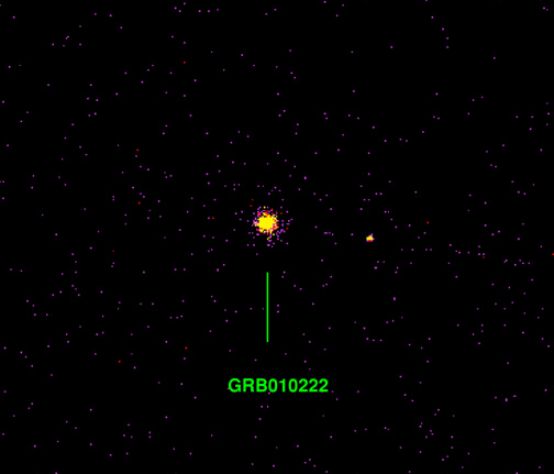Explanation: A fading afterglow from one of the most powerful explosions in the universe is centered in this false color image from the spacebased Chandra X-ray Observatory. The cosmic explosion, an enormously bright gamma-ray burst (GRB), originated in a galaxy billions of light-years away and was detected by the BeppoSAX satellite on February 22. GRB010222 was visible for only a few seconds at gamma-ray energies, but its afterglow was followed for days by x-ray, optical, infrared and radio instruments. These Chandra observations of the GRB's x-ray glow hours after the initial explosion suggest an expanding fireball of material moving at near light speed has hit a wall of relatively dense gas. While the true nature of gamma-ray bursters remains unknown, the mounting evidence from GRB afterglows does indicate that the cosmic blasts may be hypernovae -- the death explosions of very massive, short-lived stars embedded in active star forming regions. As the hypernova blasts sweep up dense clouds of material in the crowded star forming regions they may also trigger more star formation.
1999 2000 2001 2002 2003 2004 2005 2006 2007 2008 2009 2010 2011 2012 2013 2014 2015 2016 2017 2018 2019 2020 2021 2022 2023 2024 2025 |
Январь Февраль Март Апрель Май Июнь Июль Август Сентябрь Октябрь Ноябрь Декабрь |
NASA Web Site Statements, Warnings, and Disclaimers
NASA Official: Jay Norris. Specific rights apply.
A service of: LHEA at NASA / GSFC
& Michigan Tech. U.
|
Публикации с ключевыми словами:
звездообразование - гамма-всплески - gamma-ray burst - afterglow - hypernova - star formation - послесвечение - гиперновая
Публикации со словами: звездообразование - гамма-всплески - gamma-ray burst - afterglow - hypernova - star formation - послесвечение - гиперновая | |
См. также:
Все публикации на ту же тему >> | |
